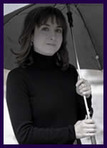Amanda McCabe's Blog, page 19
June 24, 2017
Heroine of the Weekend: Edith Cavell
(I'm currently at the Historical Novel Society conference--more on that next week when I am home and over Conference Fatigue, lol! But today we have a Heroine for a belated Memorial Day tribute, Nurse Edith Cavell, who lost her life in WWI)
 Edith Cavell (1865-1915) was a vicar's daughter, educated at Norwich School for Girls, who started her working career as a governess in Belgium (which gave her a lifelong love for the country, where she could indulge in interests in art and her facility for languages) before returning for nurse's training in London and jobs in various hospitals, where she as always seen as a compassionate and efficient medical professional. She was recruited to be matron at a new nurses' training school in Brussels, and by 1910 had launched nursing journals, recruiting nurses for over 3 hospitals and 24 new branches of the school, just in time for the huge demand of World War I.
Edith Cavell (1865-1915) was a vicar's daughter, educated at Norwich School for Girls, who started her working career as a governess in Belgium (which gave her a lifelong love for the country, where she could indulge in interests in art and her facility for languages) before returning for nurse's training in London and jobs in various hospitals, where she as always seen as a compassionate and efficient medical professional. She was recruited to be matron at a new nurses' training school in Brussels, and by 1910 had launched nursing journals, recruiting nurses for over 3 hospitals and 24 new branches of the school, just in time for the huge demand of World War I.
The Red Cross took over the hospital when the war started, and Cavell became a war nurse. She also helped wounded British soldiers out of occupied Belgium into the Netherlands, becoming part of a large network of underground escape routes. She was arrested by the Germans on august 3, 1915 and charged with harboring Allied soldiers.
She was held in prison for 10 weeks, confessing to sheltering 60 British and 15 French soldiers, as well as French and Belgian civilians before being condemned to death. The British diplomatic service could do nothing for her, despite the fact that she was a British national and should not have been charged with treason. On the night before she was executed, she wrote "Patriotism is not enough. I must have no hatred or bitterness toward anyone." (the words now carved on her statue in Trafalgar Square). She was executed by firing squad on October 11, and her death was a huge propaganda tool for the Allied cause.
 After the war, she was taken back to England for a service at Westminster Abbey and laid to rest at her family home in Norwich.
After the war, she was taken back to England for a service at Westminster Abbey and laid to rest at her family home in Norwich.
 Edith Cavell (1865-1915) was a vicar's daughter, educated at Norwich School for Girls, who started her working career as a governess in Belgium (which gave her a lifelong love for the country, where she could indulge in interests in art and her facility for languages) before returning for nurse's training in London and jobs in various hospitals, where she as always seen as a compassionate and efficient medical professional. She was recruited to be matron at a new nurses' training school in Brussels, and by 1910 had launched nursing journals, recruiting nurses for over 3 hospitals and 24 new branches of the school, just in time for the huge demand of World War I.
Edith Cavell (1865-1915) was a vicar's daughter, educated at Norwich School for Girls, who started her working career as a governess in Belgium (which gave her a lifelong love for the country, where she could indulge in interests in art and her facility for languages) before returning for nurse's training in London and jobs in various hospitals, where she as always seen as a compassionate and efficient medical professional. She was recruited to be matron at a new nurses' training school in Brussels, and by 1910 had launched nursing journals, recruiting nurses for over 3 hospitals and 24 new branches of the school, just in time for the huge demand of World War I.The Red Cross took over the hospital when the war started, and Cavell became a war nurse. She also helped wounded British soldiers out of occupied Belgium into the Netherlands, becoming part of a large network of underground escape routes. She was arrested by the Germans on august 3, 1915 and charged with harboring Allied soldiers.
She was held in prison for 10 weeks, confessing to sheltering 60 British and 15 French soldiers, as well as French and Belgian civilians before being condemned to death. The British diplomatic service could do nothing for her, despite the fact that she was a British national and should not have been charged with treason. On the night before she was executed, she wrote "Patriotism is not enough. I must have no hatred or bitterness toward anyone." (the words now carved on her statue in Trafalgar Square). She was executed by firing squad on October 11, and her death was a huge propaganda tool for the Allied cause.
 After the war, she was taken back to England for a service at Westminster Abbey and laid to rest at her family home in Norwich.
After the war, she was taken back to England for a service at Westminster Abbey and laid to rest at her family home in Norwich.
Published on June 24, 2017 17:54
May 28, 2017
Heroine of the Weekend: Frida Kahlo
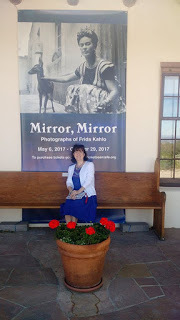 One of the things I missed about doing this blog was finding Heroines to feature every weekend--women in history both famous and not-so-famous (and sometimes not even very heroic!), but who I found to be interesting. Today I'm taking a look at the artist Frida Kahlo, because I just happened to go to an exhibit last week centered around her life. ("Mirror, Mirror: Photographs of Frida Kahlo" at the Spanish Colonial Arts Museum). I've always been fascinated by her (as so many people are!) and loved getting a closer look at her life and style.
One of the things I missed about doing this blog was finding Heroines to feature every weekend--women in history both famous and not-so-famous (and sometimes not even very heroic!), but who I found to be interesting. Today I'm taking a look at the artist Frida Kahlo, because I just happened to go to an exhibit last week centered around her life. ("Mirror, Mirror: Photographs of Frida Kahlo" at the Spanish Colonial Arts Museum). I've always been fascinated by her (as so many people are!) and loved getting a closer look at her life and style.Frida Kahlo (1907-1954) was born Magdalena Carmen Frieda Kahlo y Calderon in Coyocoan, Mexico City, to a Mexican mother and German photographer father, and had 3 sisters, growing up in the Casa Azul (now a museum, and on my bucket list). At age 6, she was stricken with polio, bedridden for months and emerging with a pronounced limp. Her father encouraged her to get into sports, and she enrolled in 1922 at the National Preparatory School (one of the few female students), and took art classes. But her new life didn't last long. On September 17, 1925, she was horribly injured in a trolley crash, spending months in the hospital and then facing a lifetime of surgeries and constant pain. But she took that pain, that suffering, and used it in an art never seen before, one that was deeply personal, graphic, and often surreal. She also became radical in her politics, joining the Mexican Communist Party.
In 1928, she met the famous mural painter Diego Rivera, and married him the next year. They spent much time on the move for his work, living in California, New York City, and Detroit for many years. Affairs by both partners (including one by Rivera with Frida's sister), as well as several miscarriages and professional complications (Rivera was famously fired from a mural project at Rockefeller Center for sneaking in a portrait of Lenin to the image). They divorced in 1939, Kahlo then moving for a time to Paris, but remarried the next year and stayed together for the rest of Kahlo's life, though living in separate but conjoined houses/studios.
 The 1950s were a time of increasingly bad health, and Kahlo became almost completely bedridden, especially after a leg amputation (though she had an easel installed above her bed and continued working!). In 1953, she had her first solo exhibit in Mexico, and was taken to the opening party by ambulance, where she drank and partied from a specially installed bed. She died July 13, 1954 at age 47, at Casa Azul. In 2002, a movie of her life was made with Salma Hayak nominated as an Oscar for her main role.
The 1950s were a time of increasingly bad health, and Kahlo became almost completely bedridden, especially after a leg amputation (though she had an easel installed above her bed and continued working!). In 1953, she had her first solo exhibit in Mexico, and was taken to the opening party by ambulance, where she drank and partied from a specially installed bed. She died July 13, 1954 at age 47, at Casa Azul. In 2002, a movie of her life was made with Salma Hayak nominated as an Oscar for her main role.I've always been in awe of her strength, her uniqueness, her great talent, her fearlessness, and her ability to know and be true to herself. She's really a Heroine.
Published on May 28, 2017 12:00
May 25, 2017
What Amanda Is Doing Now
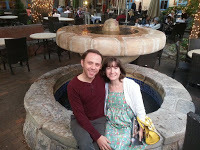 So, what have I been up to while this blog has been on (too long) hiatus??? It turns out, a lot. Some back to back deadlines, a little illness, husband's new job, and just enjoying living in my favorite place on earth, Santa Fe, has been sucking away energy. But now I am VERY pleased to announce there are many, many projects in the pipeline here.
So, what have I been up to while this blog has been on (too long) hiatus??? It turns out, a lot. Some back to back deadlines, a little illness, husband's new job, and just enjoying living in my favorite place on earth, Santa Fe, has been sucking away energy. But now I am VERY pleased to announce there are many, many projects in the pipeline here.I've just finished the first title in a new mystery series, written by a whole new persona--Amanda Allen! Santa Fe Mourning, book one in the Madeline Alwin 1920s Mysteries, will be out from Crooked Lane Books in the summer of 2018. Maddie is an artist and heiress from New York, widowed too young by World War I, who lands in sunny Santa Fe to pursue her artistic career, solve some murders, and (maybe) even find some new romance. Look for a pre-order link soon!
Amanda McCabe is also still at work. I've started the first in a whole new historical romance series, "The Grantley Girls Go To Paris," a trilogy centered around 3 heroines who become BFFs at Miss Grantley's School For Elegant Young Ladies, and are now off to the Paris Exposition of 1889 to find adventure and love. Miss Diana Martin, the heroine of the first book (title TBA) is a fashion journalist, so I am forced (forced, I tell you!) to research many Worth gowns and get out my scrapbooks of Paris trips of my own. In the meantime, my next historical romance, The Wallflower's Mistletoe Wedding, (the latest in the Bancrofts of Barton Park Series) is going to be out just in time for the holidays in November. (you can pre-order here)
Here are a few Worth creations to enjoy for the moment (I also have a House of Worth page on Pinterest, where I spend way too much time!), and I promise I will be back here very soon, with more Heroines, more cocktails, and more lovely summer patio reviews!
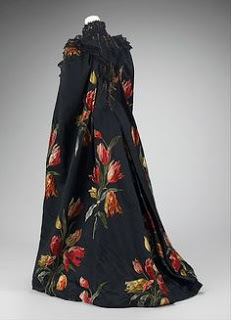
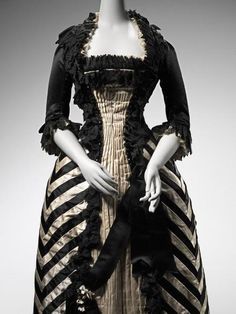
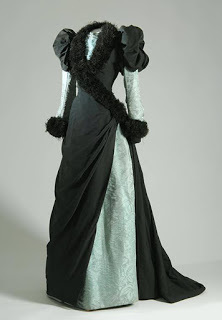
Published on May 25, 2017 15:29
November 6, 2016
Heroine of the Weekend: Emily Wilding Davison
I've been much too neglectful of this blog lately (thanks, deadlines and medical non-fun things!) but with Election Day coming up on Tuesday (finally!) I've been thinking a lot about the sacrifices so very many people have made so I can go to the polls in peace. Some of them gave literally everything.
 Emily Wilding Davison (1872-1913) was an English suffragist, a woman of immense intelligence and dedication. She was arrested 9 times, subjected to the notorious method if force-feeding 49 times, which weakened her health considerably. She was very well-educated for the times, attending Kensington Preparatory School and St. Hugh's, Oxford, where she took first-class honors but women were not allowed degrees at that time. She went on to work as a governess and teacher. Later she took a degree in Modern Foreign Languages at the University of London.
Emily Wilding Davison (1872-1913) was an English suffragist, a woman of immense intelligence and dedication. She was arrested 9 times, subjected to the notorious method if force-feeding 49 times, which weakened her health considerably. She was very well-educated for the times, attending Kensington Preparatory School and St. Hugh's, Oxford, where she took first-class honors but women were not allowed degrees at that time. She went on to work as a governess and teacher. Later she took a degree in Modern Foreign Languages at the University of London.
In 1906, she joined Emmeline Pankhurst's WSPU and dedicated her whole life to its cause of winning the vote for women, becoming one of the most dedicated and passionate of its members. Her most famous exploit came on census night, April 2, 1911. She hid in a cupboard in the Palace of Westminster, so she could list her official residence as the House of Commons. A plaque placed on the cupboard door in 1990 marks the occasion. In 1912, in Holloway Prison, she threw herself down an iron staircase to protest the brutal practice of force-feeding hunger strikers. She survived, but was in pain for the rest of her life.
On June 4, 1913, she bought a train ticket to attend the famous Epsom Derby. King George's horse, Anmer, far back from the leaders, came around the corner, and she stepped out in front of him, being knocked down and fatally injured. She died four days later. Her true motivations that day are unclear. She probably did not intend to commit suicide, though she would of course have known the great risks. She had a return rail ticket, as well as a ticket to a suffrage benefit dance and plans for a holiday in France with her sister. Film of the event shows something in her hand,, perhaps a suffrage banner later found near her, and she might have intended to throw it over the horse's bridle. Eyewitnesses nearby stated they thought she merely meant to cross the track, thinking the horses had all passed. Whatever the intention, her sacrifice was a terrible sadness and brought much attention to the cause she so loved.
 Her funeral was attended by thousands of suffragists, accompanying the coffin to her hometown of Morpeth, Northumberland in their white gowns and sashes.
Her funeral was attended by thousands of suffragists, accompanying the coffin to her hometown of Morpeth, Northumberland in their white gowns and sashes.
In her memory, and in that of thousands of others who fought and died for this basic right of any human being, please, please vote.
https://www.theguardian.com/society/2013/may/26/emily-davison-suffragette-death-derby-1913
 Emily Wilding Davison (1872-1913) was an English suffragist, a woman of immense intelligence and dedication. She was arrested 9 times, subjected to the notorious method if force-feeding 49 times, which weakened her health considerably. She was very well-educated for the times, attending Kensington Preparatory School and St. Hugh's, Oxford, where she took first-class honors but women were not allowed degrees at that time. She went on to work as a governess and teacher. Later she took a degree in Modern Foreign Languages at the University of London.
Emily Wilding Davison (1872-1913) was an English suffragist, a woman of immense intelligence and dedication. She was arrested 9 times, subjected to the notorious method if force-feeding 49 times, which weakened her health considerably. She was very well-educated for the times, attending Kensington Preparatory School and St. Hugh's, Oxford, where she took first-class honors but women were not allowed degrees at that time. She went on to work as a governess and teacher. Later she took a degree in Modern Foreign Languages at the University of London.In 1906, she joined Emmeline Pankhurst's WSPU and dedicated her whole life to its cause of winning the vote for women, becoming one of the most dedicated and passionate of its members. Her most famous exploit came on census night, April 2, 1911. She hid in a cupboard in the Palace of Westminster, so she could list her official residence as the House of Commons. A plaque placed on the cupboard door in 1990 marks the occasion. In 1912, in Holloway Prison, she threw herself down an iron staircase to protest the brutal practice of force-feeding hunger strikers. She survived, but was in pain for the rest of her life.
On June 4, 1913, she bought a train ticket to attend the famous Epsom Derby. King George's horse, Anmer, far back from the leaders, came around the corner, and she stepped out in front of him, being knocked down and fatally injured. She died four days later. Her true motivations that day are unclear. She probably did not intend to commit suicide, though she would of course have known the great risks. She had a return rail ticket, as well as a ticket to a suffrage benefit dance and plans for a holiday in France with her sister. Film of the event shows something in her hand,, perhaps a suffrage banner later found near her, and she might have intended to throw it over the horse's bridle. Eyewitnesses nearby stated they thought she merely meant to cross the track, thinking the horses had all passed. Whatever the intention, her sacrifice was a terrible sadness and brought much attention to the cause she so loved.
 Her funeral was attended by thousands of suffragists, accompanying the coffin to her hometown of Morpeth, Northumberland in their white gowns and sashes.
Her funeral was attended by thousands of suffragists, accompanying the coffin to her hometown of Morpeth, Northumberland in their white gowns and sashes.In her memory, and in that of thousands of others who fought and died for this basic right of any human being, please, please vote.
https://www.theguardian.com/society/2013/may/26/emily-davison-suffragette-death-derby-1913
Published on November 06, 2016 12:24
July 28, 2016
Abigail's Patio Review: 315 Restaurant
 Happy summer, everyone! It's been a busy one here (hence the much too long lag time on this blog!), and a scorcher, but there's been time for outdoor music, poolside reading, and best of all--summer patio dining! Living in Santa Fe has been great for Abigail, since she is welcome on almost any restaurant's patio (a very dog-friendly town!)
Happy summer, everyone! It's been a busy one here (hence the much too long lag time on this blog!), and a scorcher, but there's been time for outdoor music, poolside reading, and best of all--summer patio dining! Living in Santa Fe has been great for Abigail, since she is welcome on almost any restaurant's patio (a very dog-friendly town!)Last month, we spent Memorial Day at Abby's favorite place, 315 Restaurant and Wine Bar (be sure and check out their website here!) Why is her favorite, you ask? A spacious, shady patio, very friendly waitstaff (who always remember her name and ask about her when we dine there without her), extensive wine list (though it's been an almost all rose, all time summer for me), classic French bistro food and interesting specials (go right now--it's squash blossom season!), yummy desserts. Tuesdays are half-price wine night (any bottle is half off, so a good time to splurge a bit!), so that's our 315 night of the week. Nothing better than some steak frites, some chilled rose, and a Santa Fe sunset. Take a little walk around the plaza after and indulge in some summertime people-watching!
 Abby gives it 4 out of 5 barks (because sometimes the service is a little uncoordinated, and Poodle perfection is hard to find...)
Abby gives it 4 out of 5 barks (because sometimes the service is a little uncoordinated, and Poodle perfection is hard to find...)
Published on July 28, 2016 12:33
June 3, 2016
Heroine of the Weekend: Queen Elizabeth II
 This year is all about the queen! With her Diamond Jubilee so recently behind us, and her 90th birthday this year, we're seeing a lot about Queen Elizabeth, and I love it. She is certainly a great heroine, who has devoted her long life to hard work and service, and long may she reign. We all know the details of her life, so I thought it would be fun to take a look at a few trivia facts...
This year is all about the queen! With her Diamond Jubilee so recently behind us, and her 90th birthday this year, we're seeing a lot about Queen Elizabeth, and I love it. She is certainly a great heroine, who has devoted her long life to hard work and service, and long may she reign. We all know the details of her life, so I thought it would be fun to take a look at a few trivia facts...She speaks fluent French and often uses the language for audiences and state visits. She does not require an interpreter.She's received over 3.5 million items of correspondence during her reign.Since 1952, she has conferred over 404,500 honors and awards.Queen Elizabeth II is Britain's 40th monarch since William the Conqueror was crowned.About 1.5 million people have attended garden parties at Buckingham Palace or the Palace of Holyroodhouse in Scotland since Elizabeth has been on the throne.Over the course of her reign, she has given regular Tuesday-evening audiences to 12 British Prime Ministers, starting with Winston ChurchillShe is patron of more than 600 charities and organizations.In the past 60 years, the Queen has undertaken 261 official overseas visits, including 96 state visits, to 116 different countries.In 2005, she claimed ownership of 88 cygnets (young swans) on the River Thames. They are looked after by a swan marker. The first royal swan keeper was appointed around the 12th century. Technically, the Queen still owns the sturgeons, whales and dolphins in the waters around the U.K. A statute from 1324, during the reign of King Edward II, states, "Also the King shall have ... whales and sturgeons taken in the sea or elsewhere within the realm." This statute is still valid today, and sturgeons, porpoises, whales and dolphins are recognized as "fishes royal"The Queen joined Facebook in November 2010, with a page called the British Monarchy, which features royal news, photos, videos and speeches. (I doubt she will play Candy Crush, though)
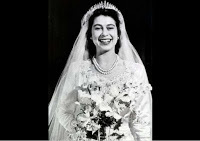 Elizabeth was the first British monarch to celebrate her diamond wedding anniversary. Elizabeth has sent more than 175,000 telegrams to centenarians in the U.K. and the Commonwealth, and more than 540,000 telegrams to couples in the U.K. and the Commonwealth celebrating their diamond wedding anniversary. In an average year, the Queen hosts more than 50,000 people at banquets, lunches, dinners, receptions and garden parties at Buckingham Palace. The Queen and the Duke of Edinburgh have sent over 37,500 Christmas cards during her reign and she has given out approximately 90,000 Christmas puddings to staff, continuing the custom of King George V and King George VI. In addition, the Queen gives her entire staff gifts at ChristmastimeElizabeth learned to drive in 1945, when she joined the women's branch of the British army. Both she and Winston Churchill's daughter were members of the group, which was called the Auxiliary Territorial Service. She was a Girl Guide (1937), a Scouting movement for girls and a Sea Ranger (1943), a section of the Girl Guides focused on sailing.An important innovation during her reign was the opening in 1962 of a new gallery at Buckingham Palace to display items from the royal collection. The brainchild of the Duke of Edinburgh, the Queen's Gallery occupied the palace's bomb-damaged private chapel. It was the first time that parts of the palace had been opened to the general public. The only time the Queen has had to interrupt an overseas tour was in 1974, during a tour of Australia and Indonesia. She was called back from Australia when a general election was announced suddenly. The Duke of Edinburgh continued the program in Australia, and Elizabeth rejoined the tour in Indonesia.
Elizabeth was the first British monarch to celebrate her diamond wedding anniversary. Elizabeth has sent more than 175,000 telegrams to centenarians in the U.K. and the Commonwealth, and more than 540,000 telegrams to couples in the U.K. and the Commonwealth celebrating their diamond wedding anniversary. In an average year, the Queen hosts more than 50,000 people at banquets, lunches, dinners, receptions and garden parties at Buckingham Palace. The Queen and the Duke of Edinburgh have sent over 37,500 Christmas cards during her reign and she has given out approximately 90,000 Christmas puddings to staff, continuing the custom of King George V and King George VI. In addition, the Queen gives her entire staff gifts at ChristmastimeElizabeth learned to drive in 1945, when she joined the women's branch of the British army. Both she and Winston Churchill's daughter were members of the group, which was called the Auxiliary Territorial Service. She was a Girl Guide (1937), a Scouting movement for girls and a Sea Ranger (1943), a section of the Girl Guides focused on sailing.An important innovation during her reign was the opening in 1962 of a new gallery at Buckingham Palace to display items from the royal collection. The brainchild of the Duke of Edinburgh, the Queen's Gallery occupied the palace's bomb-damaged private chapel. It was the first time that parts of the palace had been opened to the general public. The only time the Queen has had to interrupt an overseas tour was in 1974, during a tour of Australia and Indonesia. She was called back from Australia when a general election was announced suddenly. The Duke of Edinburgh continued the program in Australia, and Elizabeth rejoined the tour in Indonesia.
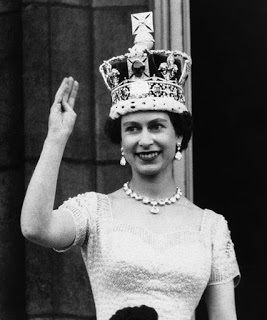 She has opened Parliament every year except 1959 and 1963, when she was expecting her children Prince Andrew and Prince Edward, respectively.She went on her first state visit as Princess Elizabeth to South Africa with her mother and father, then King and Queen, from February to May 1947. The tour included Zimbabwe, Bechuanaland, Swaziland and Basutoland (now Lesotho). The Princess celebrated her 21st birthday in Cape Town. Her first state visit as Queen was to Kenya: her father King George VI died, and she acceded the throne during the tour, which had to be abandoned. Her first Commonwealth tour began on Nov. 24, 1953, and included visits to Bermuda, Jamaica, Panama, Fiji, Tonga, New Zealand, Australia, the Cocos Islands, Ceylon, Aden, Uganda, Libya, Malta and Gibraltar. The total distance covered was 43,618 miles (70,196 km).Elizabeth has owned more than 30 corgis during her reign, starting with Susan, who was a present for her 18th birthday in 1944. A good proportion of these have been direct descendants from Susan. Elizabeth currently has five corgis: Emma, Linnet, Monty, Holly and Willow. She takes a keen interest in horses and racing. Her first pony, a Shetland called Peggy, was given to her by her grandfather King George V when she was 4 years old. Elizabeth continues to ride at Sandringham, Balmoral and Windsor. The Queen also takes interest in horse breeding. Horses bred at the royal studs over the past 200 years have won virtually every major race in Britain. Elizabeth has about 25 horses in training each season.As a young girl, Elizabeth acted in a number of pantomimes during World War II, including playing Prince Florizel in Cinderella in 1941. The productions took place every year in the Waterloo Chamber at Windsor Castle..The last and only other British monarch to celebrate her Diamond Jubilee was Queen Victoria in 1897, at the age of 77. At 86, Queen Elizabeth will be the oldest monarch to celebrate this occasion.
She has opened Parliament every year except 1959 and 1963, when she was expecting her children Prince Andrew and Prince Edward, respectively.She went on her first state visit as Princess Elizabeth to South Africa with her mother and father, then King and Queen, from February to May 1947. The tour included Zimbabwe, Bechuanaland, Swaziland and Basutoland (now Lesotho). The Princess celebrated her 21st birthday in Cape Town. Her first state visit as Queen was to Kenya: her father King George VI died, and she acceded the throne during the tour, which had to be abandoned. Her first Commonwealth tour began on Nov. 24, 1953, and included visits to Bermuda, Jamaica, Panama, Fiji, Tonga, New Zealand, Australia, the Cocos Islands, Ceylon, Aden, Uganda, Libya, Malta and Gibraltar. The total distance covered was 43,618 miles (70,196 km).Elizabeth has owned more than 30 corgis during her reign, starting with Susan, who was a present for her 18th birthday in 1944. A good proportion of these have been direct descendants from Susan. Elizabeth currently has five corgis: Emma, Linnet, Monty, Holly and Willow. She takes a keen interest in horses and racing. Her first pony, a Shetland called Peggy, was given to her by her grandfather King George V when she was 4 years old. Elizabeth continues to ride at Sandringham, Balmoral and Windsor. The Queen also takes interest in horse breeding. Horses bred at the royal studs over the past 200 years have won virtually every major race in Britain. Elizabeth has about 25 horses in training each season.As a young girl, Elizabeth acted in a number of pantomimes during World War II, including playing Prince Florizel in Cinderella in 1941. The productions took place every year in the Waterloo Chamber at Windsor Castle..The last and only other British monarch to celebrate her Diamond Jubilee was Queen Victoria in 1897, at the age of 77. At 86, Queen Elizabeth will be the oldest monarch to celebrate this occasion.
Published on June 03, 2016 14:31
April 17, 2016
Heroine of the Weekend: Madame de Sevigne
 This weekend we take a quick look at one of the most famous and erudite letter-writers in history, Marie de Rabutin-Chantal, the Marquise de Sevigne, who died on April 17, 1696. She's known now as one of the most representative figures of the Enlightenment.
This weekend we take a quick look at one of the most famous and erudite letter-writers in history, Marie de Rabutin-Chantal, the Marquise de Sevigne, who died on April 17, 1696. She's known now as one of the most representative figures of the Enlightenment.Born February 5, 1626 to an old, aristocratic family, she found herself an orphan by the age of 7, and was raised by her maternal grandparents and uncle, who gave her an excellent education. She was married on August 4, 1644 to another scion of an old family, Henri, the marquis de Sevigne of Brittany, who had an ancient name but not much fortune. The marriage produced two children, Francoise (b. 1646), who would be the recipient of most of her mother's famous letters, and Charles (b. 1648), but her husband died in a duel over his mistress in 1651. Marie never remarried, devoting herself to her children and the intellectual life of the Paris salons.
In 1669, her beloved daughter married the comte de Grignon, who was soon appointed governor of Provence, and in their separation the stream of letters began, where the two discoursed about religion, philosophy, government, and the arts as well as family matters. Buy 1673, the letters were being circulated and widely read.
According to the Encyclopedia of Philosophy, Sevigne's moral psychology explores the amatory structure of human desire and the difficulty of accepting one’s mortality. Representative of neoclassicism, her philosophy of art privileges the values of harmony, proportion, and balance. An avid reader of theological and philosophical works, she provides a running commentary on the theories of her favorite contemporary authors. Her letters reflect the intellectual sophistication of the period’s salon culture, where the philosophical controversies spawned by Cartesianism had become the object of everyday discussion.
 For more info on her fascinating life, I like Francis Mossiker's Madame de Sevigne: a Life and Letters (1983)
For more info on her fascinating life, I like Francis Mossiker's Madame de Sevigne: a Life and Letters (1983)
Published on April 17, 2016 16:26
April 14, 2016
Abigail's Patio Reviews: Upper Crust Pizza
 Last night, Abigail visited one of her favorite casual spots around Santa Fe (and very near her beloved Plazaland, for walking off some of the pizza and wine after!), Upper Crust Pizza. She gives it 4 barks out of 5, for the excellent pizza with a wide array of premium ingredients (faves include kalamata olives, sun-dried tomatoes, and goat cheese), and their lovely whole wheat crust. It doesn't hurt that they have (very) full pours of wine, including her mama's beloved Gruet Chardonnay.
Last night, Abigail visited one of her favorite casual spots around Santa Fe (and very near her beloved Plazaland, for walking off some of the pizza and wine after!), Upper Crust Pizza. She gives it 4 barks out of 5, for the excellent pizza with a wide array of premium ingredients (faves include kalamata olives, sun-dried tomatoes, and goat cheese), and their lovely whole wheat crust. It doesn't hurt that they have (very) full pours of wine, including her mama's beloved Gruet Chardonnay.The location is lovely, with a long portal fronting Old Santa Fe Trail where there is great people (and dog) watching, in a portion of "the oldest home in America" (built in the 17th/18th century), with twisty little adobe rooms. Live music and fun employees make it even better. (and it's very dog friendly). Abby especially recommends the great lunch specials (3.99 for a slice, drink, and salad??!!)
Check them out here, and join Abigail for pizza and wine some night soon....
Published on April 14, 2016 17:33
March 29, 2016
Abigail's Patio Reviews: The Teahouse
 There are so, so many things we've loved about Santa Fe since moving to Santa Fe last year! Beautiful weather, the mountains, art and music, interesting people, great food. One of the best is the way so many restaurants have patios, and thy don't just allow dogs, they love them! Our little Poodle fur-baby, Abigail, loves it now that the weather is getting warm again and she can visit her favorite spots. It's especially good for her now that she has a stroller, and can see the table and be part of the party!
There are so, so many things we've loved about Santa Fe since moving to Santa Fe last year! Beautiful weather, the mountains, art and music, interesting people, great food. One of the best is the way so many restaurants have patios, and thy don't just allow dogs, they love them! Our little Poodle fur-baby, Abigail, loves it now that the weather is getting warm again and she can visit her favorite spots. It's especially good for her now that she has a stroller, and can see the table and be part of the party!She started the season today, with a walk up Canyon Road and lunch at The Teahouse. Abigail gives them 3 out of 5 Barks. Pluses: a pretty garden that welcomes dogs (there were at least 6 other puppies for her to meet!), an extensive tea menu (dozens of teas, all varieties--we tried an Imperial Grade Sencha, light and delicate, and a nice, smoky Lapsang Souchong, I like it the stronger the better), and tasty food (a simple lunch, a panini and a beet/goat cheese salad). Minuses: a very long wait and slow service, which seems par for the course there. If you have time for a leisurely meal, and just want to sit around with your dog in the shade, it's great. If you're on a quick work lunch, not so much.
 Abigail says she now looks forward to sharing all her favorite patios with you this spring. :)
Abigail says she now looks forward to sharing all her favorite patios with you this spring. :)The website for The Teahouse
Published on March 29, 2016 18:05
March 27, 2016
Heroine of the Weekend--Empress Marie Feodorovna
Happy Easter, everyone! I am taking a small break from stuffing myself with Reese's Peanut Butter Eggs (the most perfect food in the world) to take a look at another heroine, the vivacious and courageous Dowager Empress Marie of Russia (owner of the gorgeous Winter Egg).
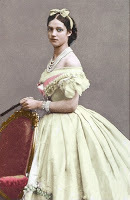 She was born, as all fairy princesses should be, in a palace, as Princess Dagmar of Denmark, second daughter of King Christian IX (the first being the future Queen Alexandra of England, Dagmar's lifelong best friend). The family was relatively poor as far as royal families went, but were very close to each other, and had a lighthearted time together. Dagmar loved to swim and ride, play cards, and collect dogs. In 1864, she became betrothed to the Tsarevich Nicholas of Russia ("Nixa") a handsome and sensitive young man, whom she sincerely loved. Sadly, he died in April of 1865, leaving Dagmar broken-hearted. She was comforted by letters from Nicholas's brother, Alexander, and in June 1866 she accepted his proposal. They were married in a lavish ceremony at the Winter Palace on November 9, after she converted to Orthodoxy and was named Marie Feodorovna. Of the wedding night, her new husband wrote, I took off my slippers and my silver embroidered robe and felt the body of my beloved next to mine... How I felt then, I do not wish to describe here. Afterwards we talked for a long time
She was born, as all fairy princesses should be, in a palace, as Princess Dagmar of Denmark, second daughter of King Christian IX (the first being the future Queen Alexandra of England, Dagmar's lifelong best friend). The family was relatively poor as far as royal families went, but were very close to each other, and had a lighthearted time together. Dagmar loved to swim and ride, play cards, and collect dogs. In 1864, she became betrothed to the Tsarevich Nicholas of Russia ("Nixa") a handsome and sensitive young man, whom she sincerely loved. Sadly, he died in April of 1865, leaving Dagmar broken-hearted. She was comforted by letters from Nicholas's brother, Alexander, and in June 1866 she accepted his proposal. They were married in a lavish ceremony at the Winter Palace on November 9, after she converted to Orthodoxy and was named Marie Feodorovna. Of the wedding night, her new husband wrote, I took off my slippers and my silver embroidered robe and felt the body of my beloved next to mine... How I felt then, I do not wish to describe here. Afterwards we talked for a long time
Welcomed by her new win-laws, the new Grand Duchess quickly made herself very popular in Russia. Pretty, outgoing, fashionable, she became a leader of Society as well as renowned for her charitable activities (especially the founding of new hospitals and orphanages, as well as patronizing the arts), she was exactly what the country wanted. She also quickly did her foremost duty of heir-producing. Nicholas was born in May 1868, followed by Alexander in 1869 (who died in infancy), George, Xenia, Michael, and Olga (1882). She proved a loving if slightly commanding mother (much like her sister Alexandra).
In March 1881, tragedy struck. Her father-in-law, Alexander II, was assassinated, leaving Marie with sharp, lifelong anxieties for her family--Our happiest and serenest times are now over. My peace and calm are gone, for now I will only ever be able to worry about Sasha.
 She was crowned with her husband on May 27, 1883, in a lavish ceremony at the Kremlin, attended by over 8000 guests, including her sister, who stayed for many weeks. After, the Imperial family moved to Gatchina, a 900-room palace a few miles outside St. Petersburg for security reasons. Marie missed the lively city life, the balls and theaters, though her husband preferred the quieter, more spartan life of Gatchina. Despite their different temperments, they loved each other all their marriage, and had a very successeful union.
She was crowned with her husband on May 27, 1883, in a lavish ceremony at the Kremlin, attended by over 8000 guests, including her sister, who stayed for many weeks. After, the Imperial family moved to Gatchina, a 900-room palace a few miles outside St. Petersburg for security reasons. Marie missed the lively city life, the balls and theaters, though her husband preferred the quieter, more spartan life of Gatchina. Despite their different temperments, they loved each other all their marriage, and had a very successeful union.
But it wasn't one that last as long as she would have liked. By 1894, it was clear that the formerly robust tsar was very ill, The choice of wife by their son Nicholas also had them worried. Alix of Hesse-Darmstadt, granddaughter of Queen Victoria, was beautiful, but also shy, retiring, and in poor health most of the time, not strong enough for the challenges of life in Russia. But Nicholas was in love, and reluctantly his parents agreed to the engagements. Marie would never have much in common with her daughter-in-law, and often disapproved of her behavior, but the couple were married a week after Alexander's funeral.
 Marie was still the leader of Society, since Alexandra seldom cared to take precedence, and she also often traveled abroad. In 1906, she and her sister bought a danish villa, Hvidore, which would prove to be her last home. In 1914, she was in England when war broke out, and rushed back to Russia. There she threw herself into the war effort, becoming president of the Russian Red Cross and outfitting hospital trains. In 1916, concerned about the evil effects of Rasputin on her son's family and unable to reason with him, she moved to Kiev, and it was from there that she fled to the Crimea when revolution exploded. At first, she refused to leave Russia, sure that rumors her son was dead were not true, until her sister persuaded her to come to England. King George sent the warship "Marlborough" to fetch his aunt, and she left with other relatives, carrying one Faberge egg with her, in 1919.
Marie was still the leader of Society, since Alexandra seldom cared to take precedence, and she also often traveled abroad. In 1906, she and her sister bought a danish villa, Hvidore, which would prove to be her last home. In 1914, she was in England when war broke out, and rushed back to Russia. There she threw herself into the war effort, becoming president of the Russian Red Cross and outfitting hospital trains. In 1916, concerned about the evil effects of Rasputin on her son's family and unable to reason with him, she moved to Kiev, and it was from there that she fled to the Crimea when revolution exploded. At first, she refused to leave Russia, sure that rumors her son was dead were not true, until her sister persuaded her to come to England. King George sent the warship "Marlborough" to fetch his aunt, and she left with other relatives, carrying one Faberge egg with her, in 1919.
 She made her home in Denmark, a leader of the Russian exiles, and always hoped her son would prove to be alive. She still believed that when she herself died, October 13, 1928, and was buried at Roskilde Cathedral. In 2006, her dearest wish was finally carried out, and she was reburied next to her husband in the Cathedral of Peter and Paul in St. Petersburg.
She made her home in Denmark, a leader of the Russian exiles, and always hoped her son would prove to be alive. She still believed that when she herself died, October 13, 1928, and was buried at Roskilde Cathedral. In 2006, her dearest wish was finally carried out, and she was reburied next to her husband in the Cathedral of Peter and Paul in St. Petersburg.
I love Marie for her energy, style, and level-headed intelligence, and also feel heartbroken for her in all the sorrow she had at the end of her life.
A great source for more about her is Coryne Hall's Little Mother of Russia: A Biography of Empress Marie Feodorovna (2006)
 She was born, as all fairy princesses should be, in a palace, as Princess Dagmar of Denmark, second daughter of King Christian IX (the first being the future Queen Alexandra of England, Dagmar's lifelong best friend). The family was relatively poor as far as royal families went, but were very close to each other, and had a lighthearted time together. Dagmar loved to swim and ride, play cards, and collect dogs. In 1864, she became betrothed to the Tsarevich Nicholas of Russia ("Nixa") a handsome and sensitive young man, whom she sincerely loved. Sadly, he died in April of 1865, leaving Dagmar broken-hearted. She was comforted by letters from Nicholas's brother, Alexander, and in June 1866 she accepted his proposal. They were married in a lavish ceremony at the Winter Palace on November 9, after she converted to Orthodoxy and was named Marie Feodorovna. Of the wedding night, her new husband wrote, I took off my slippers and my silver embroidered robe and felt the body of my beloved next to mine... How I felt then, I do not wish to describe here. Afterwards we talked for a long time
She was born, as all fairy princesses should be, in a palace, as Princess Dagmar of Denmark, second daughter of King Christian IX (the first being the future Queen Alexandra of England, Dagmar's lifelong best friend). The family was relatively poor as far as royal families went, but were very close to each other, and had a lighthearted time together. Dagmar loved to swim and ride, play cards, and collect dogs. In 1864, she became betrothed to the Tsarevich Nicholas of Russia ("Nixa") a handsome and sensitive young man, whom she sincerely loved. Sadly, he died in April of 1865, leaving Dagmar broken-hearted. She was comforted by letters from Nicholas's brother, Alexander, and in June 1866 she accepted his proposal. They were married in a lavish ceremony at the Winter Palace on November 9, after she converted to Orthodoxy and was named Marie Feodorovna. Of the wedding night, her new husband wrote, I took off my slippers and my silver embroidered robe and felt the body of my beloved next to mine... How I felt then, I do not wish to describe here. Afterwards we talked for a long timeWelcomed by her new win-laws, the new Grand Duchess quickly made herself very popular in Russia. Pretty, outgoing, fashionable, she became a leader of Society as well as renowned for her charitable activities (especially the founding of new hospitals and orphanages, as well as patronizing the arts), she was exactly what the country wanted. She also quickly did her foremost duty of heir-producing. Nicholas was born in May 1868, followed by Alexander in 1869 (who died in infancy), George, Xenia, Michael, and Olga (1882). She proved a loving if slightly commanding mother (much like her sister Alexandra).
In March 1881, tragedy struck. Her father-in-law, Alexander II, was assassinated, leaving Marie with sharp, lifelong anxieties for her family--Our happiest and serenest times are now over. My peace and calm are gone, for now I will only ever be able to worry about Sasha.
 She was crowned with her husband on May 27, 1883, in a lavish ceremony at the Kremlin, attended by over 8000 guests, including her sister, who stayed for many weeks. After, the Imperial family moved to Gatchina, a 900-room palace a few miles outside St. Petersburg for security reasons. Marie missed the lively city life, the balls and theaters, though her husband preferred the quieter, more spartan life of Gatchina. Despite their different temperments, they loved each other all their marriage, and had a very successeful union.
She was crowned with her husband on May 27, 1883, in a lavish ceremony at the Kremlin, attended by over 8000 guests, including her sister, who stayed for many weeks. After, the Imperial family moved to Gatchina, a 900-room palace a few miles outside St. Petersburg for security reasons. Marie missed the lively city life, the balls and theaters, though her husband preferred the quieter, more spartan life of Gatchina. Despite their different temperments, they loved each other all their marriage, and had a very successeful union.But it wasn't one that last as long as she would have liked. By 1894, it was clear that the formerly robust tsar was very ill, The choice of wife by their son Nicholas also had them worried. Alix of Hesse-Darmstadt, granddaughter of Queen Victoria, was beautiful, but also shy, retiring, and in poor health most of the time, not strong enough for the challenges of life in Russia. But Nicholas was in love, and reluctantly his parents agreed to the engagements. Marie would never have much in common with her daughter-in-law, and often disapproved of her behavior, but the couple were married a week after Alexander's funeral.
 Marie was still the leader of Society, since Alexandra seldom cared to take precedence, and she also often traveled abroad. In 1906, she and her sister bought a danish villa, Hvidore, which would prove to be her last home. In 1914, she was in England when war broke out, and rushed back to Russia. There she threw herself into the war effort, becoming president of the Russian Red Cross and outfitting hospital trains. In 1916, concerned about the evil effects of Rasputin on her son's family and unable to reason with him, she moved to Kiev, and it was from there that she fled to the Crimea when revolution exploded. At first, she refused to leave Russia, sure that rumors her son was dead were not true, until her sister persuaded her to come to England. King George sent the warship "Marlborough" to fetch his aunt, and she left with other relatives, carrying one Faberge egg with her, in 1919.
Marie was still the leader of Society, since Alexandra seldom cared to take precedence, and she also often traveled abroad. In 1906, she and her sister bought a danish villa, Hvidore, which would prove to be her last home. In 1914, she was in England when war broke out, and rushed back to Russia. There she threw herself into the war effort, becoming president of the Russian Red Cross and outfitting hospital trains. In 1916, concerned about the evil effects of Rasputin on her son's family and unable to reason with him, she moved to Kiev, and it was from there that she fled to the Crimea when revolution exploded. At first, she refused to leave Russia, sure that rumors her son was dead were not true, until her sister persuaded her to come to England. King George sent the warship "Marlborough" to fetch his aunt, and she left with other relatives, carrying one Faberge egg with her, in 1919. She made her home in Denmark, a leader of the Russian exiles, and always hoped her son would prove to be alive. She still believed that when she herself died, October 13, 1928, and was buried at Roskilde Cathedral. In 2006, her dearest wish was finally carried out, and she was reburied next to her husband in the Cathedral of Peter and Paul in St. Petersburg.
She made her home in Denmark, a leader of the Russian exiles, and always hoped her son would prove to be alive. She still believed that when she herself died, October 13, 1928, and was buried at Roskilde Cathedral. In 2006, her dearest wish was finally carried out, and she was reburied next to her husband in the Cathedral of Peter and Paul in St. Petersburg.I love Marie for her energy, style, and level-headed intelligence, and also feel heartbroken for her in all the sorrow she had at the end of her life.
A great source for more about her is Coryne Hall's Little Mother of Russia: A Biography of Empress Marie Feodorovna (2006)
Published on March 27, 2016 16:42

